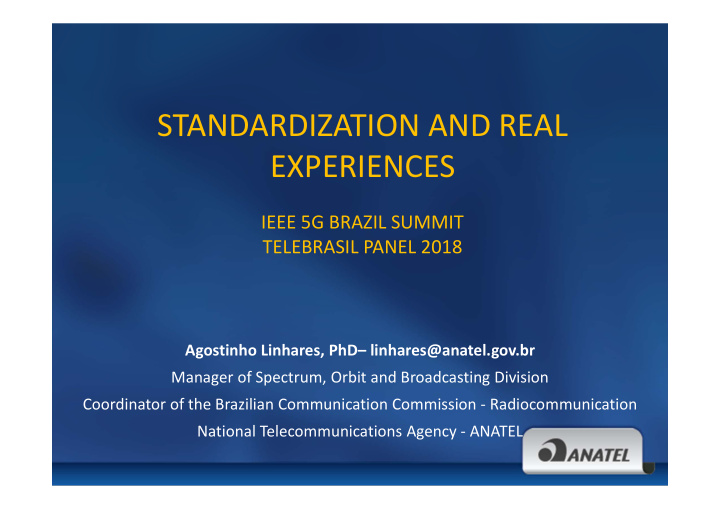



STANDARDIZATION AND REAL EXPERIENCES IEEE 5G BRAZIL SUMMIT TELEBRASIL PANEL 2018 Agostinho Linhares, PhD– linhares@anatel.gov.br Manager of Spectrum, Orbit and Broadcasting Division Coordinator of the Brazilian Communication Commission ‐ Radiocommunication National Telecommunications Agency ‐ ANATEL
A General View of the Mobile Service Sector in Brazil Access by Technology Market Share 2G: 100% Municipalities 4G: 69.1% Municipalities; 93.1% 3G: 92.5% Municipalities; 98.9% Population Population Backhaul – Optical Fiber: 58% Municipalities
The Importance of Broadcasting in Brazil DTV Stations 5.8 thousands FM Stations 3.2 thousands AM Stations 1.6 thousands Low‐power Community FM Stations 4.8 thousands
Brazilian Satellites Extremely important for Connectivity Scenario after the last auction (until 2021): STAR ONE EUTELSAT TELEBRAS SES DTH In operation HISPAMAR ECHO45 To be launched TELESAT YAH TELECOM *In red, frequency bands that are still to be deployed. 64 ° W 69,45 ° W 63 ° W 65 ° W 61 ° W 70 ° W 74 ° W 47,5 ° W 75 ° W 45 ° W 84 ° W 20 ° W 92 ° W
Spectrum forecasting for IMT‐Advanced C Mbps = N BS X B MHz X Mbps/MHz Traffic forecast increase (CAGR = 53%) Refarming Evolving technologies # of BS Increase More spectrum bands are needed Candidate bands: 1.5 GHz; 2.3 GHz; 3.5 GHz Global, or at least regional, is very desirable
Spectrum forecasting for IMT‐Advanced Magazine: Telecommunications Systems (Springer), 2017 Authors: Leandro Carísio Fernandes, Agostinho Linhares, Luciana Rabelo Novato Ferreira
Bands Identified for IMT • Rec. M-1036-5 (10/2015) Band RR Footnote (MHz) 450‐470 5.286AA 698‐960 5.313A, 5.317A 1 710‐2 025 5.384A, 5.388 2 110‐2 200 5.388 2 300‐2 400 5.384A 2 500‐2 690 5.384A 3 400‐3 600 5.430A, 5.432A, 5.432B, 5.433A • WRC-15: 470 – 698 MHz; 1427 – 1518 MHz ; 3300 – 3400 MHz; 3600 – 3700 MHz; 4800 – 4990 MHz (only 1.5 GHz is harmonized in Region 2)
Spectrum Designated for Personal Mobile Service Start Stop Start Stop (MHz) BW (MHz) (MHz) BW (MHz) (MHz) (MHz) Below 1 GHz: 222 MHz 451 458 7 1805 1880 75 461 468 7 1885 1900 15 Between 1 and 3 GHz: 575 MHz 698 806 108 1920 1930 10 806 821 15 1930 1970 40 Above 3 GHz: 200 MHz 824 849 25 1970 1980 10 851 866 15 2110 2120 10 Spectrum for coverage, 869 873 4 2120 2160 40 capacity and performance; 873 890 17 2160 2170 10 890 894 4 2300 2400 100 898,5 901 2,5 2500 2520 20 907,5 915 7,5 2520 2655 135 943,5 946 2,5 2655 2670 15 952,5 960 7,5 2670 2690 20 1710 1785 75 3400 3600 200 TOTAL 997 MHz
5G NR‐NSA
IMT‐2020
Timeline for IMT‐2020
12 IMT‐2020: Tech Performance Requirement, Submission & Evaluation Report ITU‐R M.2410 – Minimum requirements related to technical performance for IMT‐ 2020 radio interface(s) Report ITU‐R M.2411 – Requirements, evaluation criteria and submission templates for the development of IMT‐2020 Report ITU‐R M.2412 – Guidelines for evaluation of radio interface technologies for IMT‐ 2020 In addition, for the Rural‐eMBB test environment, the average spectral efficiency value should meet the threshold values for the LMLC evaluation configuration with ISD of 6 000 m and either evaluation configuration with ISD of 1 732 m.
WRC‐19 – Item 1.13 IMT‐2020: 33.25 GHz under study (mmWave) 1.13 to consider identification of frequency bands for the future development of IMT, including possible additional allocations to the mobile service on a primary basis, in accordance with Resolution 238 (WRC‐15) Band (GHz) Bandwidth (GHz) 24.25 – 27.5 3.25 31.8 – 33.4 1.6 37 – 43.5 6.5 45.5 – 50.2 4.7 50.4 – 52.6 2.2 66 – 76 10 81 – 86 5 TOTAL : 33.25 GHz a serem estudados para possível identificação.
SHARC – Sharing and Compatibility Between IMT‐ 2020 and Other Radiocommunication Systems sattelite spot beam IMT network
SHARC – Sharing and Compatibility Between IMT‐ 2020 and Other Radiocommunication Systems
Protection Criteria for Different Radiocommunication Systems
Anatel’s Regulatory Agenda • 58 regulatory projects to be initiated or approved by the end of 2018 • 20 of them related to Spectrum Management, including: – Bands for IMT • 1.5 GHz; 2.3 GHz; 3.5 GHz • LAA (5 GHz) – PDFF (NTFA) – 39.5 – 40 GHz (accordingly determination of Resolution nr. 688/2017) – Evaluation of the need to review, update and unify the technical regulations of the broadcasting services (AM, FM and TV), within the premises of consistency and regulatory quality. Regulatory Impact Analysis by 2nd / 2018. – Regulation for dynamically access the spectrum in the VHF and UHF bands. Regulatory Impact Analysis by 2 nd half / 2018. – Spectrum Pricing, including associated with Satellites
Final Comments • Spectrum deals with past, present and future • We need a stable and predictable regulatory environment to: Facilitate the deployment of new technologies, Improve service quality, Country development. • We should not overprotect incumbent services; • Development of technical skills; • Harmonization and economy of scale; • Keep an open and frank dialogue with all players.
THANK YOU! Agostinho Linhares – linhares@anatel.gov.br
Recommend
More recommend